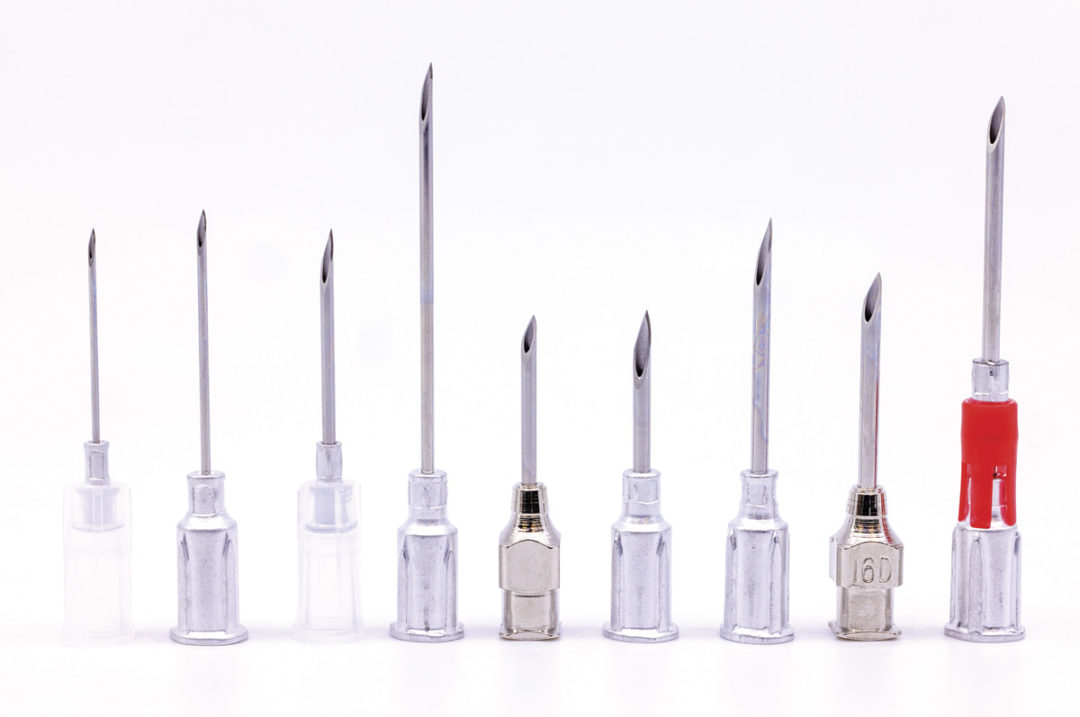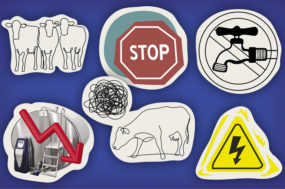To read this article in French, click here.
Whether you are new to needling cattle or a seasoned pro, the risk of injury or side effects from mishaps that may occur while performing this task are always present. We are all creatures of habit, and I am confident you can each recall a time where you caught yourself saying, “I have done that so many times, I can do it with my eyes closed.”
The reality is, however, that unintentional exposure from a needling incident can be a very stressful occurrence. Just the thought of bodily fluids or blood entering into your skin from a prick is a creepy feeling. Not to mention that this can result in pathogens such as bacteria, viruses and other microorganisms capable of causing diseases to enter into your body. Exposure can result from more than a prick injury. You also are at risk for exposure to the active ingredient contained within the drug or vaccine you are handling.
Reactions to unintentional exposure range from mild to severe. There is a wide range of reactions that can occur from respiratory distress to nerve damage to loss of pregnancy. Remember that the medications being administered have been designed for an animal with a much larger body mass and are not designed for humans.
It is important to review the label on the drug or vaccine that you are handling ahead of time so you are knowledgeable of what to do if an unintentional incident were to occur. Having a policy and procedure on needling in place, and training your team annually on this, can potentially save a life. If your team is aware of what could go wrong ahead of time, it will save them time in reacting if an injury were to occur.
Aside from a needle prick injury, there are some other ways you may come in contact with medications and vaccines while administering them to animals. They include the following:
- Skin contact: Some medications are absorbed through the skin or transferred to the mouth, eyes or nose by hands
- Eye contact: Via splash or aerosol
- Inhalation: Dust or aerosol
- Ingestion: Splash, hand-to-mouth transfer through eating, drinking or smoking
What can you do to protect yourself and your workers?
- Ensure the animal is immobilized in a headlock.
- Never put your arm between the animal and the headlock.
- Wear latex or nitrile gloves and protective clothing.
- Wear safety glasses or a face shield.
- Never place your hand or fingers in the path of a needle.
- Keep the needle shielded.
- Use safe injection techniques.
- Take care when reinstalling a shield on a needle.
- Wear a respirator when working with medications that have a vapor or dust potential.
- Do not eat, drink or smoke while handling medications.
- Always wash hands with soap and water after handling medications.
What to do if a needling injury has occurred:
- All puncture wounds from an accidental needle stick are considered dangerous, regardless of needle status (clean, sterile or used).
- Immediately notify the closest person to let them know what has happened.
- Remove contaminated clothing.
- Immediately wash the affected areas with soap and water.
- Check the label warnings for further required action.
- Disinfect the injection site.
- Contact your doctor or call the Poison Control Centre. The Ontario Poison Control emergency number is (800) 268-9017.
The proper handling of needles is important, but equally important is the method used for properly disposing of the needle. Always immediately discard sharp objects in a container designated for sharps. Do not leave them laying around or in your pocket. You can purchase a sharps container from your veterinarian or farm supply, or you can use any rigid plastic container, something as simple as a recycled plastic laundry detergent bottle, clearly labeled “contains sharps.” Lightweight plastic beverage containers should not be used as the needles could penetrate the thin plastic.
Once containers are filled 2/3 of the way full, you should seal the containers and have them removed by your vet or other appropriate disposal company. If you are disposing of the sharps containers yourself, be sure to identify landfill locations in your area that accept sharps. Never put sharps at the roadside for disposal or recycling.
Recapping needles should be avoided whenever possible, as this is a common cause of needlesticks. Directly dispose of the needle into an approved sharps container. The only time you should recap a needle is if you're not going to use it right away and you need to transport it to another location. If you must recap, use mechanical methods such as pliers or use the one-hand method following these steps for a safe way to do so:
- Place the cap on a flat surface (counter, tailgate of a truck or any safe, sturdy area).
- Using only one hand, hold the syringe by the tips of your fingers with the needle pointing away from you.
- Slowly slide the syringe along the flat surface toward the cap.
- Once the needle is well inside the cap, secure the cap with your other hand.
Needling of animals is important for your herd health, and it is equally important to maintain your team’s safety while performing this necessary task. Follow the safety precautions outlined to keep everyone healthy and safe.










